In the given table Column I shows the different values of masses of the body. Column II shows the different values of angular speed of the body and Column III shows the radius of circle in which the body moves.
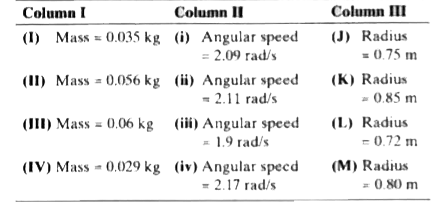
Which combination has 0.13N as the centrepetal force?
(i) (iii) (L)
(IV)(i)(M)
(II)(iv)(K)
(I)(i)(K)
The correct Answer is:D
Step by step video & image solution for In the given table Column I shows the different values of masses of the body. Column II shows the different values of angular speed of the body and Column III shows the radius of circle in which the body moves. Which combination has 0.13N as the centrepetal force? by Physics experts to help you in doubts & scoring excellent marks in Class 12 exams.
Topper's Solved these Questions
- BOOK - RESNICK AND HALLIDAYCHAPTER - CIRCULAR MOTIONEXERCISE - PRACTICE QUESTIONS(INTEGER TYPE)2videos
CIRCULAR MOTION
- BOOK - RESNICK AND HALLIDAYCHAPTER - CIRCULAR MOTIONEXERCISE - CHECK POINTS6videos
CIRCULAR MOTION
- BOOK - RESNICK AND HALLIDAYCHAPTER - CIRCULAR MOTIONEXERCISE - PRACTICE QUESTIONS(LINKED COMPREHENSION)2videos
CIRCULAR MOTION
- BOOK - RESNICK AND HALLIDAYCHAPTER - CIRCUITSEXERCISE - Practice Questions (Integer Type)3videos
CIRCUITS
- BOOK - RESNICK AND HALLIDAYCHAPTER - CURRENT AND RESISTANCEEXERCISE - Practice Questions (Integer Type)3videos
CURRENT AND RESISTANCE
Similar Questions
In the given table Column I shows the different values of masses of the body. Column II shows the different values of angular speed of the body and Column III shows the radius of circle in which the body moves.
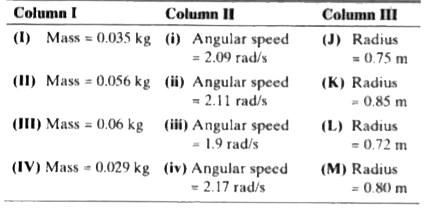
Which combination has 0.199N as the centrepetal force?View SolutionIn the given table column I shows the values of linear velocity. Column II shows the values of linear velocity, Column II shows the values of angular velocity and Column III shows the radius of the circle in which circular (angular) motion takes place.
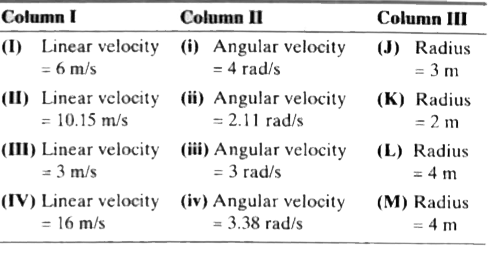
Which combination describes the conditions when body starts with zero initial linear velocty and accelerates with 2m/s2 for 3s?View Solution
Knowledge Check
- Question 1 - Select One
In each equation, there is a table having 3 columns and 4 rows. Based on the table, there are 3 questions. Each question has 4 options (a), (b), (c ) and (d), ONLY ONE of these four options is correct.
Four quantum numbers shows the electronic configuration of the element. In the given table, Column I shows the different values of principal quantum number, Column II shows the different values of angular momentum quantum number and Column III shows the energy levels for different orbitals.
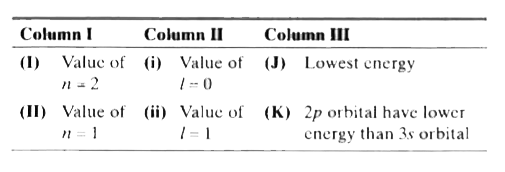
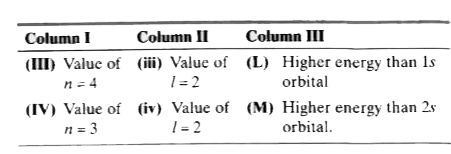
What are the characteristics of 1s orbital?A(I) (ii) (J)B(IV) (i) (M)C(II) (iv) (K)D(II) (i) (J) - Question 2 - Select One
In each equation, there is a table having 3 columns and 4 rows. Based on the table, there are 3 questions. Each question has 4 options (a), (b), (c ) and (d), ONLY ONE of these four options is correct.
Four quantum numbers shows the electronic configuration of the element. In the given table, Column I shows the different values of principal quantum number, Column II shows the different values of angular momentum quantum number and Column III shows the energy levels for different orbitals.


What are the characteristics of 2p orbital?A(III) (ii) (J)B(I) (ii) (K)C(II) (iii) (K)D(I) (i) (M) - Question 3 - Select One
In each equation, there is a table having 3 columns and 4 rows. Based on the table, there are 3 questions. Each question has 4 options (a), (b), (c ) and (d), ONLY ONE of these four options is correct.
Four quantum numbers shows the electronic configuration of the element. In the given table, Column I shows the different values of principal quantum number, Column II shows the different values of angular momentum quantum number and Column III shows the energy levels for different orbitals.


What are the characteristics of 2s orbital?A(I) (i) (L)B(I) (i) (K)C(III) (iii) (J)D(I) (ii) (M)
In the given table column I shows the values of linear velocity. Column II shows the values of linear velocity, Column II shows the values of angular velocity and Column III shows the radius of the circle in which circular (angular) motion takes place.

Which combination describes the conditions when body is displaced by 28 m in 4s and accelerates with 2m/s?View SolutionIn the given table column I shows the values of linear velocity. Column II shows the values of linear velocity, Column II shows the values of angular velocity and Column III shows the radius of the circle in which circular (angular) motion takes place.

Which combination describes the conditions when body starts with zero initial linear velocty and accelerates with 2rad/s2 for 3s?View SolutionIn each equation, there is a table having 3 columns and 4 rows. Based on the table, there are 3 questions. Each question has 4 options (a), (b), (c ) and (d), ONLY ONE of these four options is correct.
There are different types of lasers. In the given table, Colums I shows the properties of different lasers or material used in lasers, Column II shows the different names of the lasers and Column III shows the uses of different type of lasers.
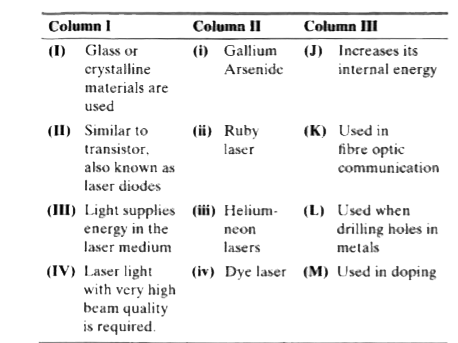
What are the characteristics of liquid state laser?View SolutionIn each equation, there is a table having 3 columns and 4 rows. Based on the table, there are 3 questions. Each question has 4 options (a), (b), (c ) and (d), ONLY ONE of these four options is correct.
There are different types of lasers. In the given table, Colums I shows the properties of different lasers or material used in lasers, Column II shows the different names of the lasers and Column III shows the uses of different type of lasers.
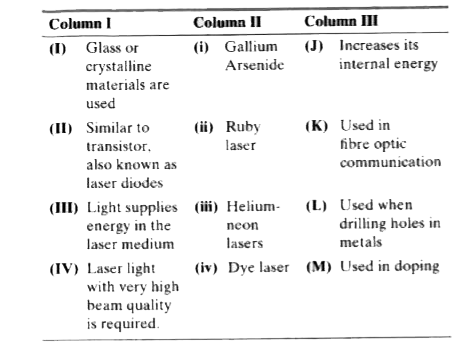
What are the characteristics of solid-state laser?View SolutionIn each equation, there is a table having 3 columns and 4 rows. Based on the table, there are 3 questions. Each question has 4 options (a), (b), (c ) and (d), ONLY ONE of these four options is correct.
There are different types of lasers. In the given table, Colums I shows the properties of different lasers or material used in lasers, Column II shows the different names of the lasers and Column III shows the uses of different type of lasers.
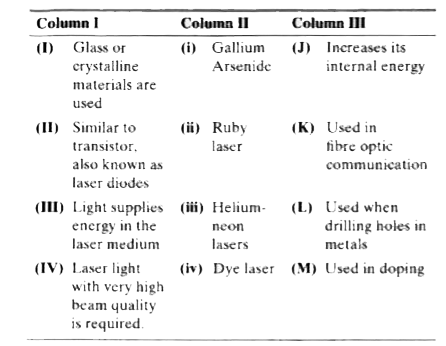
What are the characteristics of semiconductor laser?View Solution

